The Impact of Tidal River Management on Livestock in the Ganges-Brahmaputra Basin- Juniper Publishers
Journal of Dairy & Veterinary Sciences- Juniper Publishers
Abstract
Ganges-Brahmaputra Basin provides several
wetlands which are resourceful for rearing livestock as to support
coastal community and their livelihoods in the Southwest Bengal delta.
Water-logging hampers rural livelihood by damaging agricultural crops,
plant, trees, grazing land and reducing livestock. Primarily, Tidal
River Management (TRM) is introduced by coastal community to manage
tidal river-floodplain ecosystem by way of removing water-logging,
increasing navigability of tidal river, improving agriculture and
biodiversity of tidal basin, and progressing livestock which lead to
human wellbeing. The study selects Bhaina tidal basin from Southwest
Bengal delta to assess the impact of TRM on livestock and the
contribution of livestock to households’ income. The authors collected
both quantitative and qualitative data through face to face interview,
key informant interview and focus group discussion. This research finds
that, households own greater number of livestock after TRM scenario than
that of before TRM scenario. Duck achieves the top number (604)
followed by hen (378) from bird species. In addition, cow encompasses
the peak number (274) that tailed by goat number (162) from four-legged
animal. Besides, households’ income is reduced by 26% during TRM case
due to effect of salinity and improved by 50% after TRM case considering
before TRM case as the base. Sheep is a newly introduced species (found
after TRM event) and buffalo and horse are the rare among selected
eight species in the study area. Although grazing land is decreasing due
to changing cropping patters, food and fodder are available by
improving agriculture and terrestrial biodiversity. The study findings
will support policy makers to operate TRM effectively for advancing
agriculture, livestock and other ecosystem services to pastoral
livelihood in the coastal region.
Keywords:TRM scenarios; Livestock; Coastal livelihood; Impact; Bhaina tidal basin; PastoralistsIntroduction
The Ganges-Brahmaputra Basin is accompanied by
diversified occupational pattern and thereby not only depend on
agriculture but also depend on homestead vegetation and animal
husbandry. Animal husbandry is the second largest income source of
household after agriculture that predominantly governs the coastal
livelihood [1]. Valuable resources for livestock come from wetland such
as place for grazing land, water for drinking, trees for shade and
shelter, plants and grass that are fundamental need of animals.
Consequently, wetlands are often used more intensively by the
pastoralists for supporting their livelihood besides fishing and agro
farming [2]. The type of animal, its activity, feed intake, breeding and
nourishment of animals in the different life cycle stages wetland are
directly or indirectly connected to livelihoods and quality of life in
form of pasture, fodder and grains that are eaten by the animals[3].
As livestock virtually requires 5 to 20 times more water per
kg product than crop products, it is therefore, obvious that the
trend and magnitude of water-logging will have an impact on animal
production [4]. Poultry, goat and other larger domestic animals can be
feed by domestic water sources such as ponds, subsurface dams,
boreholes, and shallow tube wells but the daily food sources come from
agrarian cultivation which mostly depend on wetland [5].
The Southwest Bengal delta is one of the climates
induced vulnerable zones all over the world [6,7]. The shape and
structure of the river and floodplain directed by the water regime (e.g.
flow depth, velocity, energy) which in turn determine the type and
number of animal and plant communities[8]. Although it provides variety
of ecosystem services and benefits to the coastal community, large scale
recurrent hydro-climatic disaster, land use and occupational changes
have made the region more vulnerable that altered coastal dynamics
[9-11]. High rate of sedimentation on riverbeds and structural
interferences to the flow path of river gradually make this region
environmentally stressed [12,13]. Hari-Teka River of this region
carries a huge
amount of sediment that silted on river bed and leads its tidal
basin to water-logging by trapping monsoon rain fall inside the
basin (natural depression). Therefore, Beel Bhaina (Beel is the
local name of tidal basin), Beel Khukshia, Beel Kaderia, Beel Baruna,
Beel Madhugram, Beel Singa etc. have been experiencing
water-logging since mid-1980s by the consequences of coastal
polders.
The resulted water-logging causes serious damage to
agriculture, forestry, fisheries, physical infrastructures and
thereby impact on livestock [14]. The area suffers from scarcity
of pure drinking water, sanitation system and utility services, as
well as squeezed educational and recreational facilities. These
types of ecological and societal complexities affecting millions
of people during the past two decades under the realm of
employment, livelihoods and national economy [15]. Another
study by Masud et al.[16] captures the impact of water-logging
on biodiversity. It shows that water-logging reduces the number
birds, fisheries and livestock as well as retard vegetation and
plants growth in the study area. Climate change induced waterlogging
and contamination of surface water, soil acidity and
water salinity are the principle issues that have a serious and
prolonged impact on specious diversity, rangeland and pasture
productivity[17].
Tidal River Management (TRM) is a community-based water
resource management technique, which is now frequently being
practiced in the southwestern coastal region of Bangladesh [17-
20]. Their judgment is that if tidal flows can be allowed to enter
inside the beel, the navigability of the rivers will be restored,
and sediment will accumulate inside the polders. As a result, the
level of land of beels will rise and generate the enclosed beels
free from water-logging while improve the environment by TRM
[21]. Besides, the people must pass miserable life because not to
introduce agriculture, damage homestead garden, reduce plants,
trees, livestock and decline other livelihood options by saline
intrusion during TRM period until the land raised enough as the
tidal basin flooded two times in a day. Although TRM decreases
ecosystem services only for tidal basin during implementation
phase, it improves livelihoods by enlarging ecosystem services to
the whole catchment area. Moreover, TRM explores an improved
socio-agro-ecological system that supports agriculture, forestry,
fisheries livestock and other income generating sources to the
tidal basin after ending its operation.
Hence, the tidal river-floodplain system and its ecological
environment and human wellbeing thereafter are closely
interlinked, which has again been aggravated by structural
intervention processes [13,20,22]. In addition, coastal people
choice TRM option (has already been implemented) at Beel
Kaderia (1997-2001), East Beel Khukshia (2007-2013) and
Beel Kaderia (2002-2005) under Hari-Teka tidal river basin to
remove water-logging from floodplain, raise beel by managing
sediment and develop drainage capacity of the tidal river as to
improve their livelihoods and household’s income with offering
more ecosystem services. The proper interaction between land
and water for allocating rights to use land and water resources
concerned with pastoral livelihood, leading protection of crops,
trees, settlements and other resources make coastal people to
involve livestock rearing with high magnitude and other income
generating activities [23]. TRM formulates the management
of tidal river-floodplain ecosystem to support livestock with
grazing land, fodder and usable water in the coastal region.
The study selects Bhaina tidal basin of Southwest Bengal delta
from Ganges-Brahmaputra floodplain to identify the impact of
TRM on livestock. It attempts to assess the impact of TRM on
livestock and its contribution to household’s income considering
3 scenarios of TRM (before TRM, during TRM and after TRM).
Actors Involvement in TRM
TRM is needed to improve the water and sediment regime
with a view to keeping them functioning by flushing the sediment
inside the depressed tidal basin. In general, the government
authority Bangladesh Water Development Board (BWDB for
structural support of TRM operation), Center for Environment
and Geographic Information Services (CEGIS for mapping and
evaluating TRM), Institute of Water Modeling (IWM for monitoring
hydro-morphological change of tidal basin and tidal river during
TRM) Local Government and Engineering Department (LGED
for providing different service facilities), local government (for
supporting compensation), GOs and NGOs (for monitoring and
supporting the general people) and the community (to raise
their voice against corruption, mismanagement for proper
functioning) are the main actors engaged in TRM of a region[24].
Since TRM comes from the civil society as a community initiative
to control the natural flow of river water, let the sediment inside
the tidal basin and removing the water-logging problem but
there are no active authorities here. The major decision comes
from the community level to induce sediment inside the beels
through cut point. Besides, there are some community-based
organizations (CBOs) in the locality named “Krishok Songram
Somitty”, “Water Management Committee”, “Pani Committee”
and “Beel Management Committee” etc. and it needs strong
coordination among GOs, NGOs and CBOs to get substantial
benefits from TRM.
Milk Fat Depression
There are several researches in the contemporary literature
which deal with the mechanism, characteristics, operating
options, conflicts, consequences and sustainability impact of
TRM on coastal livelihood have been conducted in the study
area[25-27]. Furthermore, they relate TRM to climate change
adaptation, agriculture, fisheries, food security, biodiversity,
disaster management, sustainable livelihood and coastal zone
management. For this reason, the study finds out the following
research gaps are as mentioned-They do not capture the
impact of TRM on livestock regarding three events of TRM.The
contribution of livestock to household’s income is not exhibited.
Objectives of the Study
This paper fixes the following objectives to fill out the
research gaps.
a. To assess the impact of TRM on livestock.
b. To measure the contribution of livestock to household’s
income and
c. To analyze the effect of salinity on livestock at village
level during TRM operation.
Materials and Methods
Selection of the Study Area
The study selects three adjacent villages of Bhaina tidal basin
purposively, which are affected with salinity in varying degree
during TRM implementation phase. These three villages are
situated in Keshabpur sub-district under Jessore district (Figure
1). To make a comparison of the effect on livestock during TRM
implementation phase, the study selects Sholgatia village of
Dumuria sub-district under Khulna district, which has not been
affected with salinity intrusion. It is fact that this village is far
from the tidal basin and has no tidal effect to this village during
TRM operation.
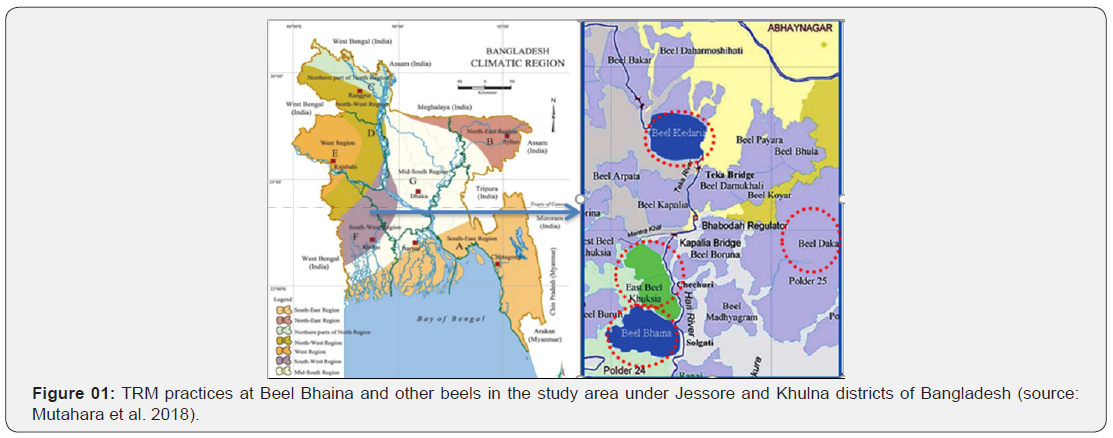
Figure 1 exhibits Map of TRM beels (Beel Bhaina, East Beel
Khukshia and Beel Kaderia) and Beel Dakatia where TRM has
been implemented through Hari-Teka River from 1997 to 2013
and Hamkura River from 1991 to 1994 respectively under
Southwest region of Bangladesh.
Data Sources
This study collects primary data from interview schedule
technique, Key Informant Interview (KII) and Focus Group
Discussion (FGD) technique. In addition, secondary data are
gathered from reports of government- and non-government
organizations as well as from published journal articles.
Sample Size Determination
Farmers who bearing more than 60 years old and have less
than 200 decimals of cultivable land at Bhaina tidal basin are the
target population in this study. The sample unit is the households,
who are considered for primary data collection. Field survey
shows that on an average 75% of the households in the studied
villages comprise less than 200 decimals of cultivable land. The
sample size (n) is determined by following the equation given by
Kothari (2004).
n= (z2 pqN)/(e2 (N-1)+ z2 pq)----- (1)
Where, z = the value of standard variate at a given confidence
level (for 95% confidence level, z is 1.96);p = sample proportion
(for 10% household, p is 0.1); q = 1 – p (q is 0.9); N = population
size of the village; e = acceptance error (within 5% true value, e
is 0.05).
This paper follows stratified random sampling to select
households for interview schedules. It includes 115 households
from target households. Table 1 provides sample size distribution
of several villages at Bhaina tidal basin. It involves the maximum
50 households from Agarhati village and the minimum 17
households from Duhuri village. Besides, farmers are in the focus
point for FGD. Members of the beel management committee,
people’s representative of local government, teachers, agrobusiness
men and other local elites who have good knowledge
about Beel Bhaina are identified for KII. The study comprises 5
FGD and 8 KII at Bhaina tidal basin.
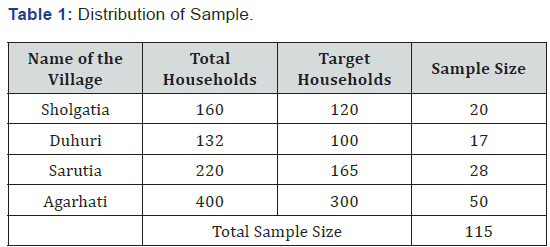
Analytical Tools and Technique
With a view to capturing the impact of TRM on livestock,
present study considers three scenarios of TRM. Following subsections make a temporal analysis about the impact of TRM
on livestock. Before TRM implies the time when water-logging
has not been appeared in the area as the cause of human
suffering. It was the normal period when people of the area did
not feel the urgency of implementing TRM. It was the time from
1960s to early 1980s (without water-logging) and mid-1980s
to 1996 (with water-logging) for this tidal basin. During TRM
implies the time when TRM was being implemented. It was from
1997 to 2001 for this area. This phase is again characterized by
inter temporal component about salinity intrusion. Field survey
shows that salinity intrusion is a major factor determining the
impact of TRM on livestock during implementation phase. This is
due to the reason that salinity affects different area by different
degrees depending on the location of the village and proximity
of that village to the tidal river. After TRM period starts from the
time when the implementation of TRM has been completed; from
2002 to 2016. Following sub-sections will address the impact of
TRM on livestock regarding different scenarios of TRM.
Present study captures the impact of TRM on livestock
holding in terms of number and percentage. It includes 8 main
species of livestock i.e. hen, duck and goose (3 bird animals)
and goat, sheep, cow, buffalo and horse (5 four legged animals)
of the Southwest delta of Bangladesh. Field level data on the
number of livestock has been collected for the assessment of
impact. This paper involves five-pointscale (disagree, strongly
disagree, neutral/no comments, agree and strongly agree) to
extract opinion form farmers in FGD regarding qualitative data.
It collects data on grazing land, fodder, soil quality and water
quality relation with salinity etc. from FGD.The underlying
reasons behind the changes in the livestock have also been
analyzed in this study.
Result and Discussion
Assessing the Impact of TRM on Livestock in the Tidal Basin
Local people in Bhaina tidal basin introduced TRM as an
indigenous and eco-friendly technique during the period of
1997-2001. Lives and livelihoods of the people dependent on
Bhaina tidal basin have changed greatly due to implementation
of TRM. Field survey shows that impacts of TRM in the study
area are dynamic, which links peoples’ lives and livelihoods with
three different scenarios of TRM. TRM, in that area was basically
implemented with a view to solving water-logging problem in
the tidal basin and removing drainage congestion of the Hari
River[28,29]. TRM connects the rivers with tidal basin through
different connecting channels, which allows the river water
coming into and coming out from the tidal basin two times per
day. This process not only allows depositing sediments in the
tidal basin, but also increases river’s water reservation capacity
and navigability.
During TRM implementation period, this technique is
supposed to alter the livestock of the tidal basin. These changes
have been more profound in an open TRM, which has been
followed by Bhaina tidal basin. Under the open TRM, village
protection dam was not built in the area, which allowed intruding
saline water even into the homestead land. Intrusion of saline
water both in the tidal basin and the homestead land changed
the structure of household production for basic sustenance and
access to cash income through altering the access to rearing
livestock. During TRM implementation phase, people in the
adjacent locality of Bhaina tidal basin captured its’ impact in
terms of reduced access to livestock, fisheries, and fruit and
timber trees, which generally are the sources of household
production and cash income. It is important to mention that
people enjoyed a reliable access to the household production
and cash income during 1980s, which was the normal time
before water logging appears in this tidal basin. However, the
cost incurred by the people during TRM implementation phase
must be outweighed by the increased benefits obtained by them
after TRM implementation phase. Against this backdrop, this
research attempts to make a comparison among three different
scenarios of TRM with reference to its’ impact on livestock in the
adjacent villages of Bhaina tidal basin.
Table 2 shows changes in the number of livestock in different
scenarios of TRM. Except sheep, all other varieties of livestock
have reduced at different rates during TRM implementation
phase, but again increased after TRM phase. Quantity of livestock
increases even more than before TRM phase, which may be the
manifestation of comparatively better living standard after TRM
implementation phase.
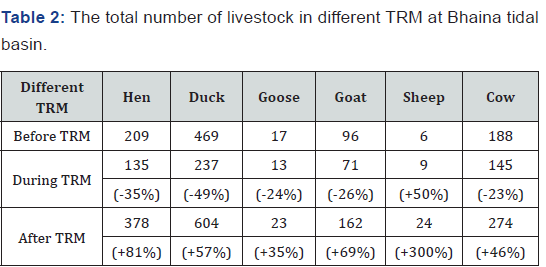
N.B.: Changes are calculated considering ‘before TRM’ situation as
the base.
In every case, the number of livestock is declined except
sheep during TRM event regarding before TRM event. It is
increased by 50% and proves that salinity has no negative effect
on sheep production. The highest 49% is decreased for duck
at this time. Buffalo and horse are not found in the study area.
Duck and cow were more popular livestock than hen and goat.
Besides, pet animals- cats and dogs were declined more than
50% during TRM but increased by more than 20% after TRM. For
bird animals, duck reaches the top number (604) which followed
by hen number (378). In addition, for four legged animals, cow
extends the peak number (274) that followed by goat number
(162) after TRM scenario comparing to before TRM scenario. He
is progressed by 81% and goat is advanced by 69% respectively
for bird animals and four legged animals after TRM phase
considering before TRM phase.
Figure 2 includes the opinion of respondents at five-point
scale from focus group discussion for the statement that ‘reduces
of grazing land’ and ‘availability of fodder’ for comparing after
TRM event to before TRM event. It exhibits that 20% respondents
are strongly agree, 60% respondents are agreed, and 20%
respondents have no comments for the statement ‘reduces
of grazing land’ at Beel Bhaina. Besides, 80% respondents
are strongly agreed, and 20% respondents are agreed for the
statement ‘availability of fodder’ at Bhaina tidal basin.

Grazing land reduction is alarming for pastoral livelihood
though fodder is available for livestock in this area. An intensive
change in agricultural pattern has been happened after TRM phase
as compare to before TRM phase. Paddy lands are converted in
to fish farms as farmers wish to get more financial benefits. Aus
(pre-monsoonal variety of paddy) and Aman (monsoonal variety
of paddy) are rarely found except Boro (post monsoonal variety
of paddy). There is no fallow land and fish is cultivated all over
the year. Therefore, grazing land is decayed largely in the Bhaina
tidal basin after TRM implementation phase. Besides, double
crops are introduced in the land at the same time i.e. fish with
vegetables and paddy with vegetables. Vegetables are grown on
the Veri (high land is surrounded of the farm) and fish/paddy is
cultivated in the main land of the farm. Sometimes, there are no
vegetables on the Veri where grass, plants and other herbs are
grown naturally. For this reason, fodder is available in the Beel.
Measuring the Contribution of Livestock to Households Income
Table 3 involves the amount of income generated from
livestock by the households. Respondents in the study area make
greater cash income after TRM implementation scenario than the
other two scenarios of TRM. After TRM phase is associated with
more favorable environmental condition for rearing and further
investing in the livestock. Gross income from livestock increases
by 50 percent after TRM being implemented. Species specific
increases range from 29% up to 300% in the study area. Greater
increase captured in case of sheep although they are fewer in
absolute number. Second highest increase in income comes
from hen followed by goat, cow, goose and duck respectively. But
during TRM phase, greater decrease in income captured in case
of duck followed by hen, goat, goose and cow correspondingly.
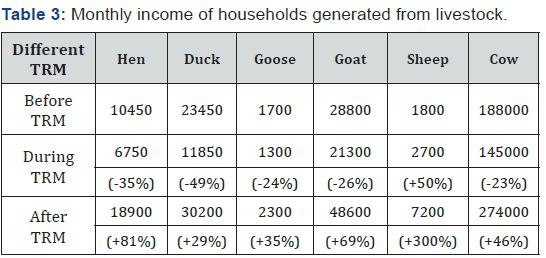
Before TRM
Present study measures the impact on number of and access
to livestock resources. In this phase, people enjoyed easy access
to livestock resources. Households owned sufficient number
and diverse category of livestock. At that time, grazing land was
available, which ensures sufficiency of food and fodder. People
had cash money generating from livestock selling, which again
became a source of investment in livestock resources.
During TRM
This phase squeezed both the number and variety of livestock
resources. This is due to the reason that TRM implementation
phase reduced the availability of grazing land as agricultural
land (Beel) and in many cases homestead lands were under
waterlogged. This situation created the scarcity of fodder for
livestock. Livelihood displacement by land inundation shrunk
the opportunity to generate cash income from livestock selling
and reduced the capacity to further invest in livestock at that
phase.
After TRM
After TRM implementation phase, increased productivity
of both land and labor force creates favorable environment for
livestock rearing as land are no more inundated and labor forces
become employed within the local area. Increase in productivity
enhances peoples’ capacity to expand household production;
greater amount of cash money holding enables the households to
purchase and invest in increased number and variety of livestock.
Figure 3 captures the total households’ income from livestock for before TRM, during TRM and after TRM scenarios at Bhaina tidal
basin. It provides that households’ income was reduced by 26%
during TRM case and improved by 50% after TRM case in view
of before TRM case.
Figure 4 comprises three main sources (i.e. agriculture,
livestock and day labor) of household income of a poor farmer.
It demonstrates that the contribution of livestock regarding
households’ income was dropped by 2% both for during TRM
and after TRM events. In addition, the role of agriculture (paddy,
fisheries and vegetables are in together) to households’ income
was increased by 11% after TRM event regarding before TRM
event. Besides, the support of day labor to household’s income
was reduced by 9% after TRM event comparing to before TRM
event. Since households’ income was progressed by 50% from
livestock (Figure 3), as a source, the contribution of livestock
to households’ income was fall down by 2% after TRM event
relating to before TRM event.
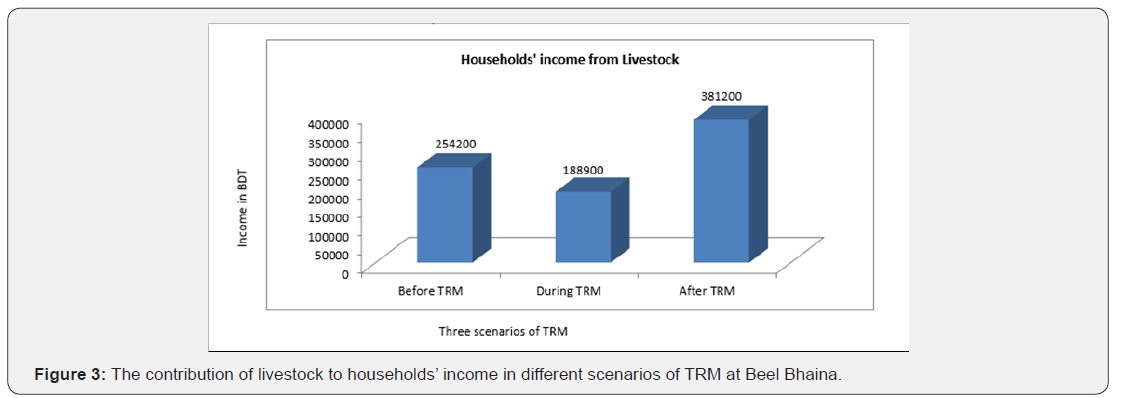

Capturing the Effect of Salinity on Livestock During TRM Implementation Phase
To capture the effect on livestock during TRM implementation
phase, the study selects three types of villages depending on the
severity of salinity in the study area. Village wise salinity types
are presented below: Sholgatia (Unaffected); Duhuri (Medium to
Strong affected); Sarutia (Medium to Strong affected); Agarhati
(Low to Medium affected). Except for Sholgatia village, salinity
affects both soil and water quality in all other villages in the
study. It has already mentioned that Beel Bhaina followed the
open TRM system, under which no village protection dam was
built surrounding the villages. For this reason, saline water
intruded inside the locality of the adjacent Hari River. Therefore,
the villages which situated close to the river have been affected
by salinity with different degree. It is important to note that
during TRM phase is characterized by decrease of all components
of livestock except Sheep. Salinity intrusion remains an added
disadvantage for villages adjacent with the river because the
rate of decrease of livestock is even more in these places. All the
respondents in the studied villages acknowledged that salinity
level has increased in both water and soil quality of the Beel,
homestead land and of the pond (Figure 5).
Figure 5 involves five components (pond’s water, beel’s water,
canal’s water, homestead’s soil and beel’s soil) of environment
in the context of effect of salinity during TRM operation phase.
It extracts opinion from farmers for the statement ‘increases
of salinity’ considering these five components. It illustrates
that 100% respondents are strongly agree for the statement
‘increases of salinity’ during TRM scenario regarding before
TRM scenario. Besides, 60% respondents are strongly agreed,
and 40% respondents are agreed for the statement ‘decreases
water pollution’ after TRM scenario concerning before and
during TRM scenarios in the study area. These opinions follow
the results of Table 2, the number and presence of livestock are reduced during TRM event due to scarcity of food and fodder
and vanishing grazing land. In addition, rearing of livestock is
developed after TRM event basis of improving accessibility of
livestock to grazing land and availability of food and fodder by
agricultural intensification at Bhaina tidal basin.

Table 4 below shows the impact of salinity on livestock
during TRM implementation phase. Greatest difference between
the two-time period (before and during TRM) has been exhibited
in case of duck, followed by hen, goat and cow in Duhuri village.
Except Sholgatia village, duck is the most affected species during
TRM phase for all the cases followed by hen, cow and goat. There
was no duck found at Duhuri village. Furthermore, duck was
declined by 50% more at Sarutia and Agarhati villages at this
time. Therefore, it is evident from the study that salinity has a
negative implication both in number and persistence of livestock
at these villages.
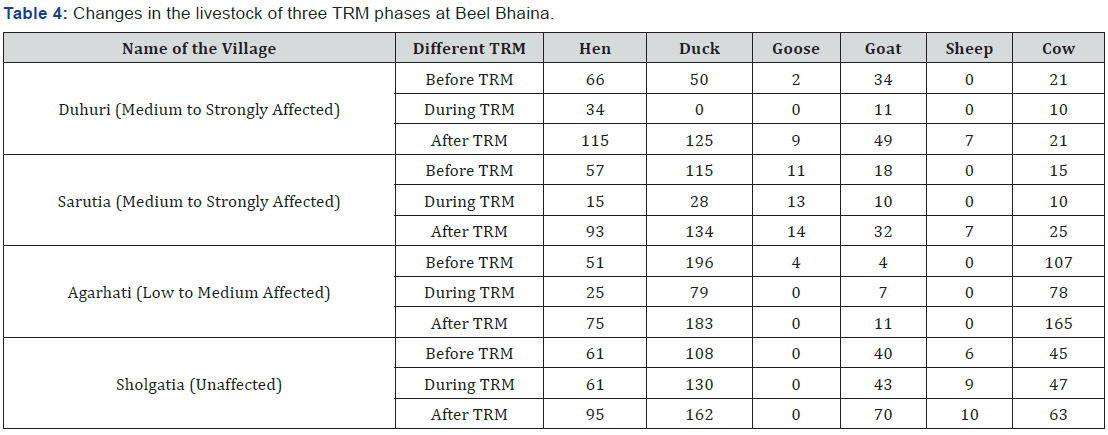
Field survey demonstrates that goose (found in 3 villages out
of 4) and sheep (found in 1 village out of 4) were rare livestock
species at Bhaina tidal basin for before TRM case. Goose was
further reduced and found in 1 village out of 4 villages during
TRM operation case.In addition, goose (found in 2 villages out
of 4) and sheep (found in 3 villages out of 4) were progressed
in number and presence during TRM implementation phase
after TRM case considering before TRM case. Moreover, hen
was plunged by 60% more at Sarutia village and 50% at Duhuri
and Agarhati villages during TRM event matching to before
TRM event. From before TRM event to during TRM event, goat
was decreased by 50% more at Duhuri village and 50% less at
Sarutia village but increased by 50% more at Agarhati village.
Furthermore, cow was dropped by 50% more at Duhuri village
and 30% more at Sarutia and Agarhati villages during TRM
phase comparing to before TRM phase. Although all livestock
species were decreased (exception for goose at Sarutia and goat
at Agarhat villages) during TRM implementation case due to
salinity these were increased both in number and survival after
TRM implementation case (removal of saline effect) bearing in
mind before TRM case.
Conclusion
Nature governs the people and people understand the nature
well. Peoples’ livelihood in the Ganges-Brahmaputra basin is
closely linked with natural resource, environmental features
and the processes continuing from generation to generation.
TRM comes to light as people’s traditional wisdom for coastal river basin management. When number of governmental and
non-governmental bodies failed to manage costal land and
water regime then Tidal River Management (TRM) seem to be
an effective and sustainable way to reform the coastal dynamics.
TRM has some socio-ecological impact on coastal livelihood
where impact on livestock and the generated income level before,
during and after TRM are a vital part of rangeland management.
The study found that water-logging condition exerts negative
impact on livestock. Likewise, TRM operational period limits
the scope of animal husbandry and the income generated from
livestock rearing thereby.
In both cases, it was due to the scarcity of food and fodder
sources and damaging grazing land, which must need attention
for providing substitute option for rearing livestock and
generating alternative income and protein sources to pastoral
community. However, it has been found that after TRM phase
generates more scope for livestock rearing due to intensification
of agricultural activities and increasing homestead vegetation.
Notwithstanding the fact, this paper does not include egg, milk
and meat production, and technological improvement and
accessibility to livestock as the alternative way to assess the
impact. The findings from this study support policy makers to
take effective decision for the improvement of livestock and
other ecosystem services to rural community in the context of
water resources management in coastal region. This research
encourages further researches to link TRM with livestock,
fisheries, agriculture, forest, biodiversity and other income
generating activities to households for sustainable pastoral
livelihood to achieve sustainable development goals.
To know more about journal of veterinary science impact factor: https://juniperpublishers.com/jdvs/index.php
To know more about Open Access journals Publishers: Juniper Publishers




Comments
Post a Comment